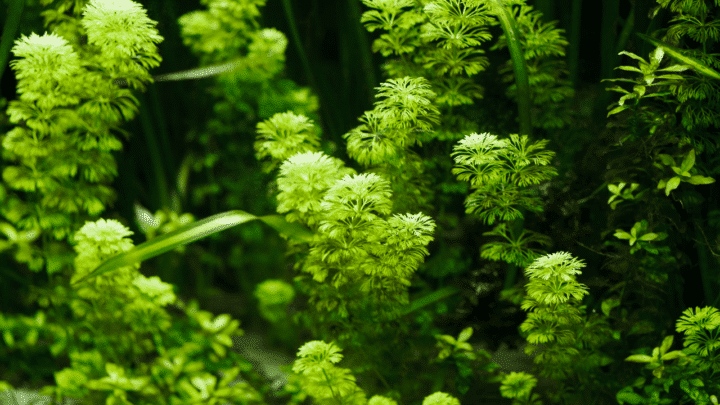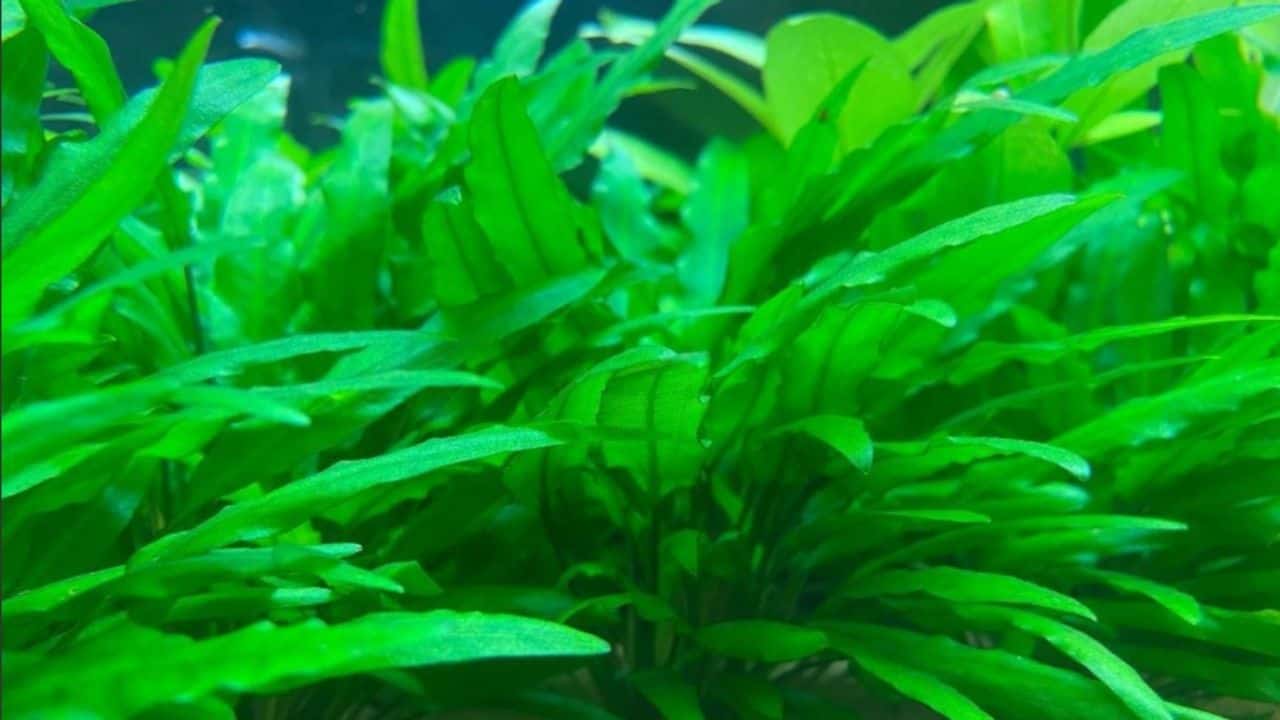There are many bushy aquarium plants for you to choose from.
However, some are still a better choice than others because few varieties of plants can live longer and survive in a diverse environment.
The 14 Best Bushy Aquarium Plants
- Marimo Moss Ball
- Cryptocoryne Wendtii
- Amazon Sword
- Aponogeton Crispus
- Christmas Moss
- Bacopa Caroliniana
- Vallisneria
- Cryptocoryne Lutea
- Java Fern
- Dwarf Sagittaria
- Rotala Indica
- Cabomba
- Ludwigia Repens
- Crinum Calamistratum
1. Marimo Moss Ball
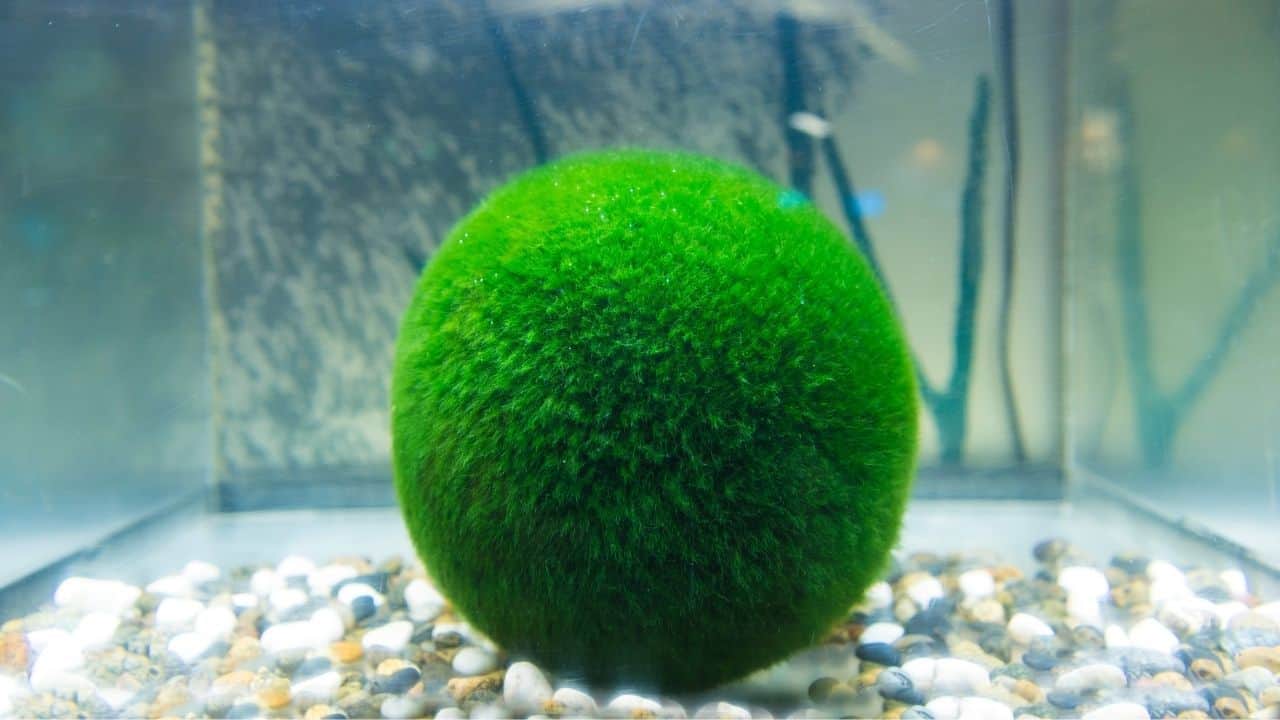
This aquarium plant is known to be the easiest to grow on the list.
The Marimo Moss Ball plant looks like a velvety green orb that is not moss or actually a plant but rather a naturally occurring cladophora algae ball.
Its main care requirements include:
- Roll the ball in your hands when you change the water. This will help maintain the round shape and give the algae access to light from all sides.
- It needs moderate to low lighting
- It needs to be kept in temperatures as high as 80 degrees Fahrenheit (26 degrees Celsius)
- It needs to be fertilized often (two to three times a month)
- CO2 injections are recommended for faster growth
By nature, Marimo Moss Ball actually grow as:
- Free-floating filaments
- Shaggy sheets
- Flat mats of rock surfaces
This plant is inexpensive and is quite unique looking compared to other aquarium plants.
People often buy a whole bunch of them to fill up their tanks to create all sorts of scenic beauty around their pets at home marine life.
2. Cryptocoryne Wendtii
Cryptocoryne Wendtii is a low-maintenance crypt known for melting back when they first enter a new aquarium.
Its binomial nomenclature and basic plant care requirements include:
- Family: Araceae
- Scientific name: Cryptocoryne wendtii
- Common name: Wendt’s Water Trumpet
- Fertilizer: Does not need it
- Cardon Dioxide injections: Not required
- Growth rate: Slow
- Lighting: any light works
- Soil: it can grow in any substrate
- Feeding: prefers to be fed by roots
- Supplements: Extra iron supplements can be used to increase redness.
The Cryptocoryne Wendtii is known to come in many different varieties, such as:
- Brown
- Green
- Red
- Tropica
Cryptocoryne Wendtii is similar to Amazon Swords since they both melt back when added to a new aquarium.
Do not be discouraged when this happens, as your plant is not dead, but rather it is just adjusting to the water.
3. Amazon Sword
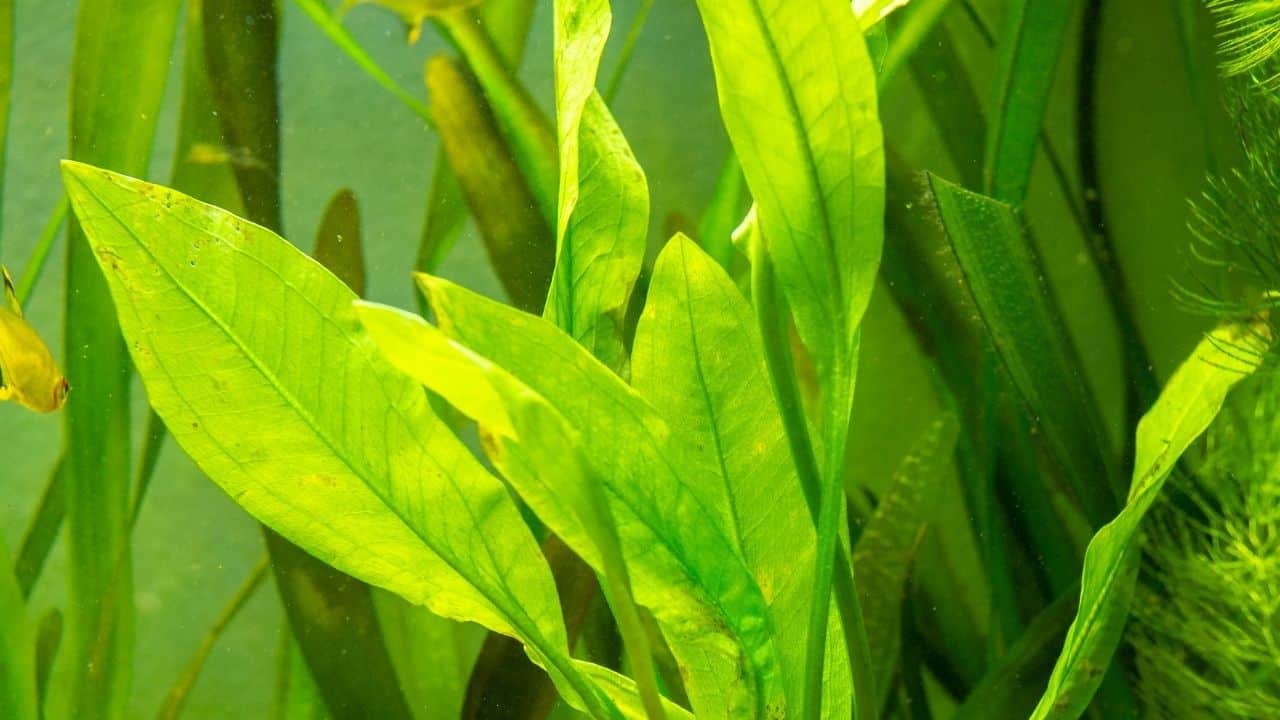
Amazon Sword is a classic aquarium plant known to grow extremely large and take over the entire aquarium.
Its binomial nomenclature and basic plant care requirements include:
- Scientific name: Echinodorus Grisebachii or Echinodorus Amazonicus
- Family: Alismataceae
- Fertilizer: Most essential requirement. It needs to be continuously fed root tabs throughout the month.
- Soil: no specific soil requirements
- Lighting: No specific requirements
- Feeding: needs to be fed by roots
When you initially purchase an Amazon Sword plant, it will look big, with lots of round leaves grown outside of water.
Once the plant is kept in water, the large leaves melt back, and longer, narrower leaves grow underwater.
If the leaves start becoming yellow, you need to add more root tabs.
Once the sword of this plant becomes large enough, it will be the mother plant and create long spikes.
4. Aponogeton Crispus
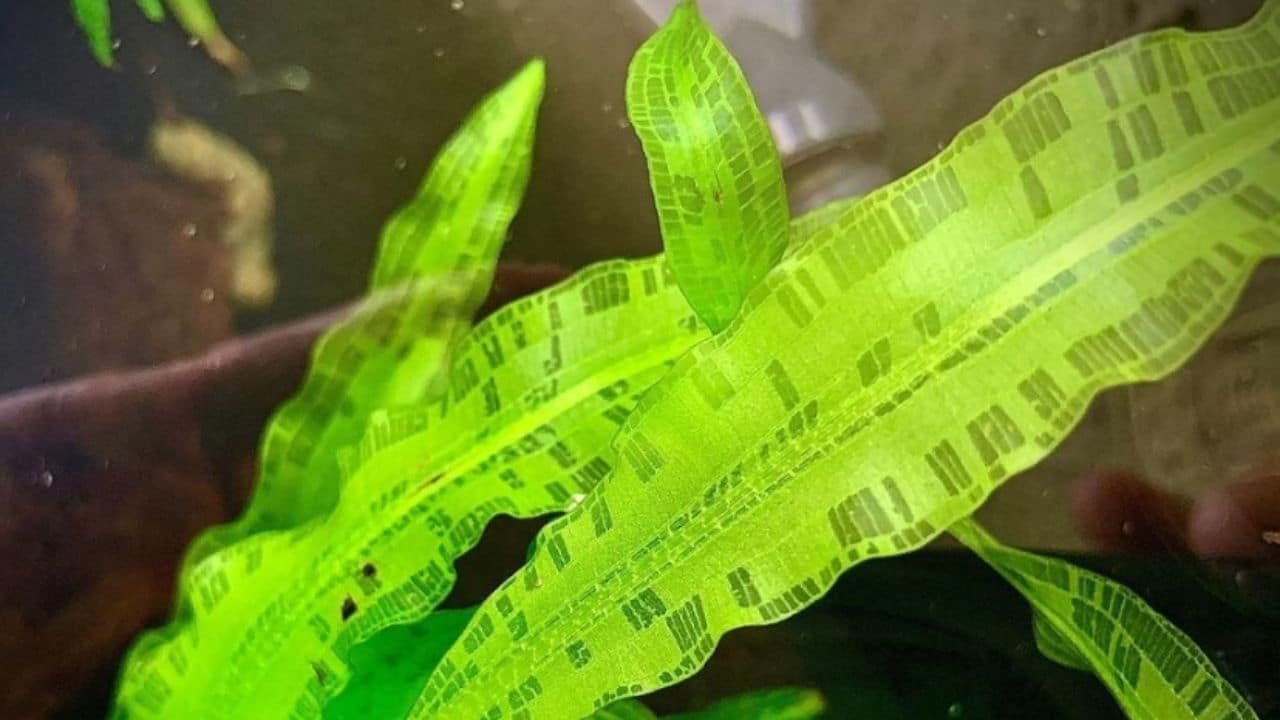
Photo Credit: @under_water_forest on Instagram!
Aponogeton Crispus is a low-light plant that is known to grow long, wavy-edged leaves. This plant grows from bulbs, and it is known to be really easy to care for.
Its binomial nomenclature and basic plant care requirements include:
- Scientific name: Aponogeton Crispus
- Common names: Kekatiya, Ruffled/Crinkled or Wavy-edged Aponogeton
- Family: Aponogetonaceae
- Fertilizer: Needs to be fed root tabs throughout the month.
- Soil: no specific soil requirements
- Lighting: No specific requirements
- Feeding: needs to be fed by roots
- Flower: produces white flowers
- Growth rate: grows fast, and tall
The species can go through dormant periods where large leaves tend to die.
Do not remove the plant from the aquarium and leave it as it is. It’ll eventually revert to its original state.
5. Christmas Moss
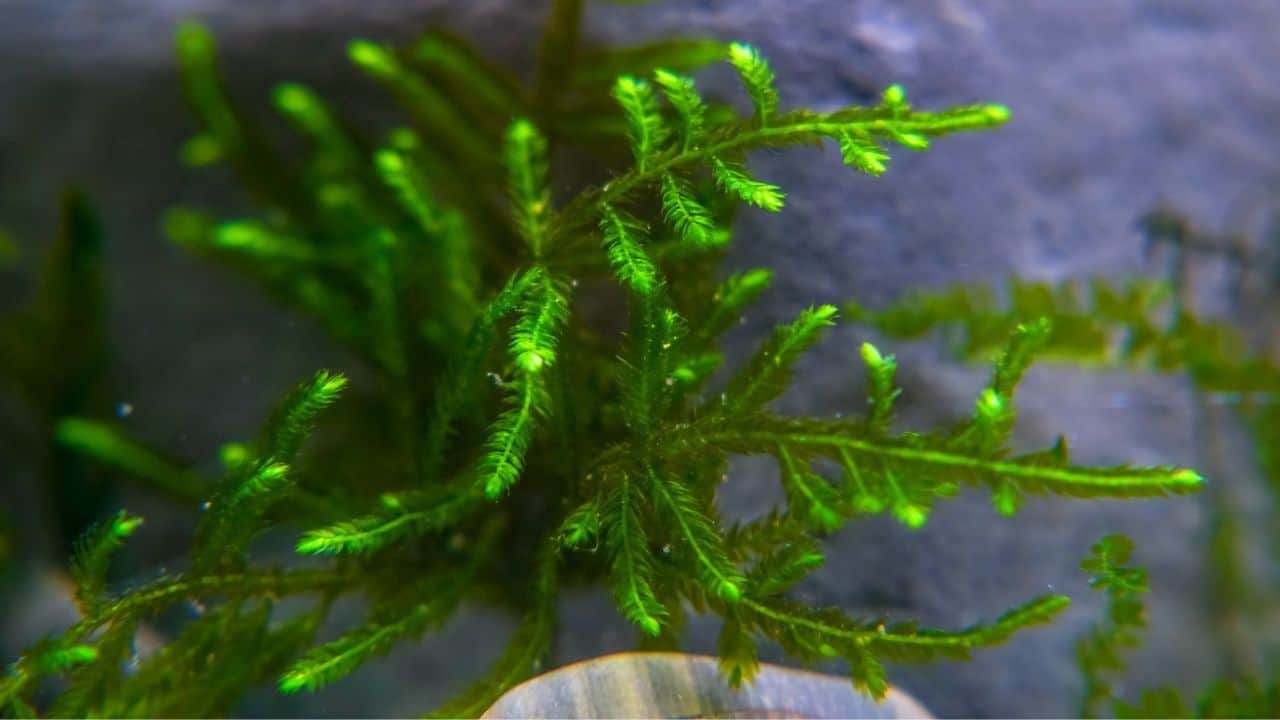
Christmas Moss is a fluffy frond that looks like a Christmas tree underwater. It is perfect for aquariums that have:
- Baby fishes
- Shrimps
- Invertebrates
It is a plant that is native to tropical Asia and can be found in the following countries:
- India
- Philippines
- Japan
- Thailand
- Sri Lanka
- Australia
Its binomial nomenclature and basic plant care requirements include:
- Scientific name: Vesicularia Montagnei
- Common names: Xmas Moss and Willow Moss
- Family: Vesicularia Montagnei
- Temperature: 65 to 77 degrees Fahrenheit (18 to 25 degrees Celsius)
- Fertilizer: does not need to be fed often.
- Soil: no specific soil requirements as it gains nutrients from the water.
- Lighting: Low to medium lighting
- Growth rate: grows slow
- Placement: can be placed anywhere in the tank
Christmas Moss is often tied to rocks and driftwood to give the illusion of overgrown moss in a forest.
To keep this plant growing well, you should:
- Buy algae eaters such as Amano shrimp
- Add liquid fertilizer
6. Bacopa Caroliniana
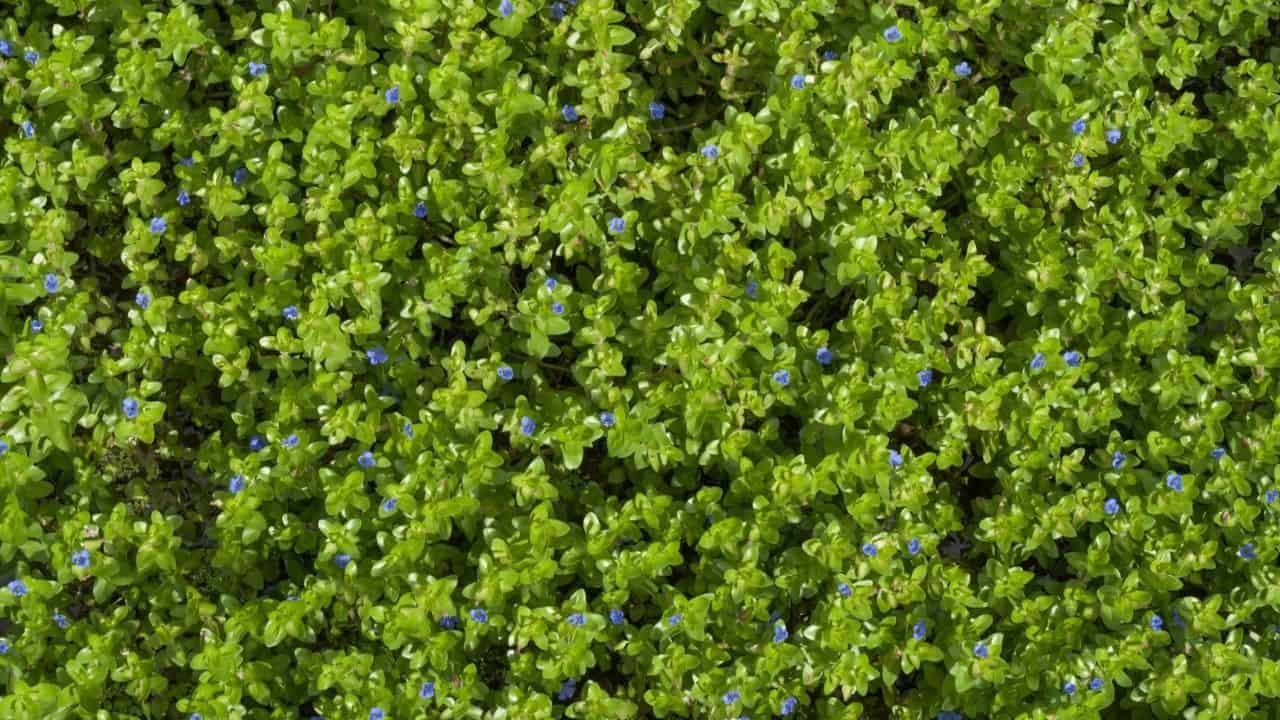
Bacopa Caroliniana is a native of the southern United States and has vertical, straight stems with round leaves.
Its binomial nomenclature and basic plant care requirements include:
- Scientific name: Bacopa Caroliniana
- Common names: Giant red bacopa, water hyssop, and lemon bacopa
- Family: Plantaginaceae
- Temperature: 39 to 84 degrees Fahrenheit (4 to 29 degrees Celsius)
- Fertilizer: Does not need fertilizers as long as the aquarium fishes produce enough waste
- pH value: 5 – 7
- Carbonate hardness: 2 – 18°dKH
- Soil: Does not have specific substrate requirement
- Lighting: Moderate to bright lighting
- Growth rate: Medium
- Placement: Placed above water
Bacopa Caroliniana is usually grown outside of water at a plant farm.
Once it is in the water, the leafy parts of the plant will remain above water.
7. Vallisneria
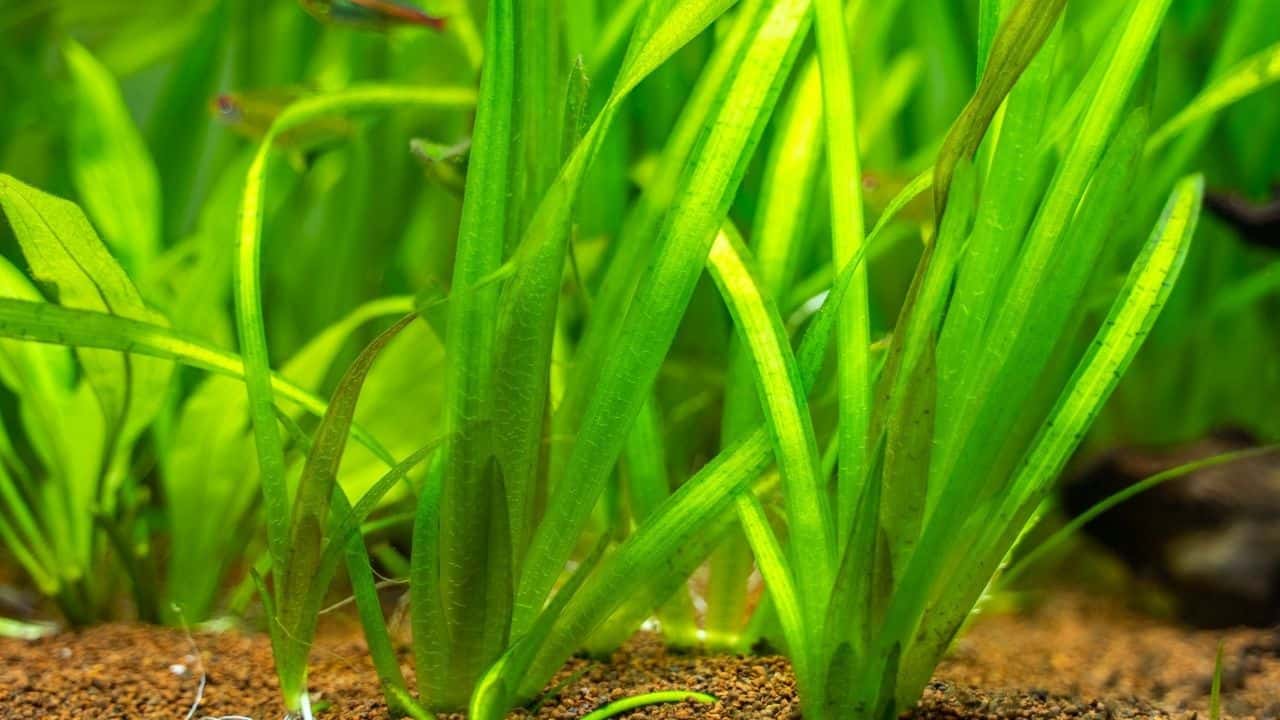
Vallisneria can help you create an underwater jungle without you having to put any effort into it.
Its binomial nomenclature and basic plant care requirements include:
- Scientific name: Vallisneria
- Common names: eelgrass, tape grass, or Vallis
- Family: Hydrocharitaceae
- Temperature: 63 to 82 degrees Fahrenheit (17-to-28-degree Celsius)
- Fertilizer: Needs to be fertilized often
- pH: 6.5-8.5
- Soil: Needs nutrient-rich soil
- Lighting: Moderate to high lighting
- Growth rate: Moderate to fast
- Placement: Background
Once your Vallisneria settles in your aquarium, you can add fish that are known to pull, eat and dig up plants such as:
- Goldfishes
- African Cichlids
- Silver Dollars
- Oscars
8. Cryptocoryne Lutea
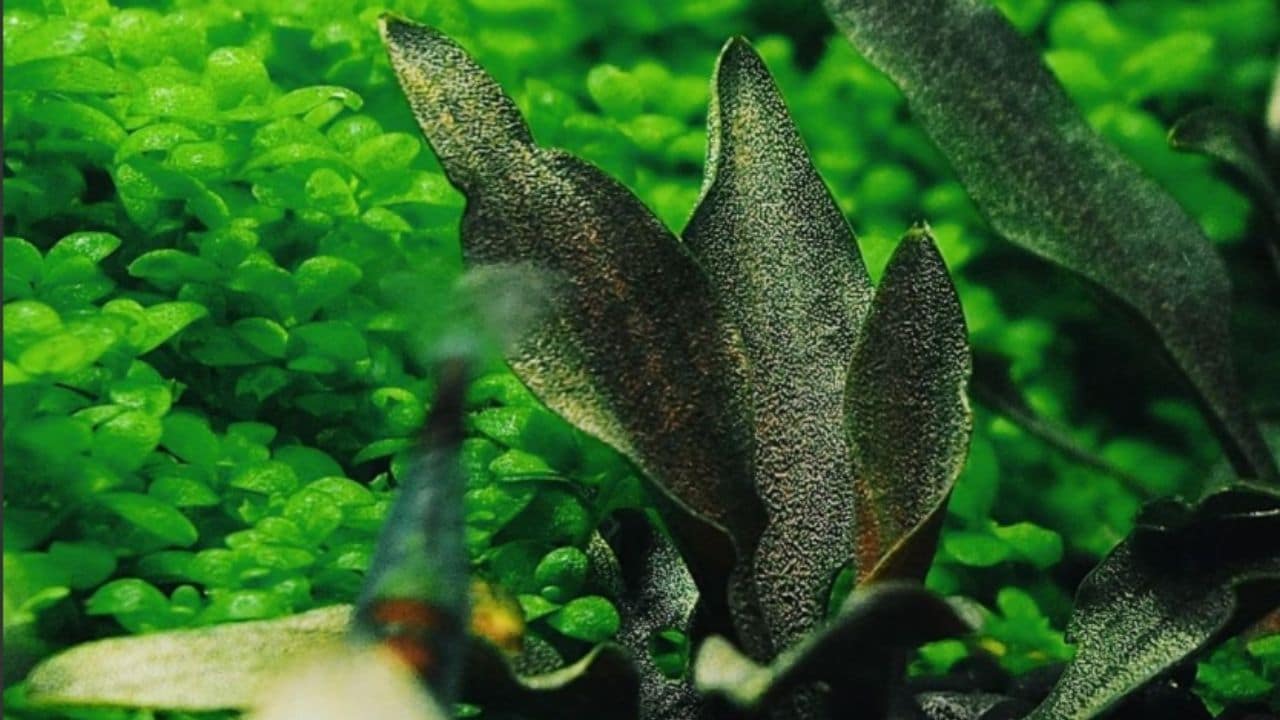
Photo Credit: @rainerszesny on Instagram!
Cryptocoryne Lutea is a beginner-friendly and undemanding plant. It has green and slender leaves that add a unique texture to your tank.
Its binomial nomenclature and basic plant care requirements include:
- Scientific name: Cryptocoryne lutea Alston
- Common names: Crypt Lutea
- Family: Araceae
- Temperature: 72 – 79-degree Fahrenheit (22 – 26 degrees Celsius)
- Fertilizer: Needs to be provided with fertilizer every week
- pH: 6.8-7.2
- Soil: It needs nutrient-rich soil with a lot of iron
- Lighting: Moderate
- Growth rate: moderate. Can grow 6 to 9 inches in height
- Placement: Midground area of the aquarium
9. Java Fern
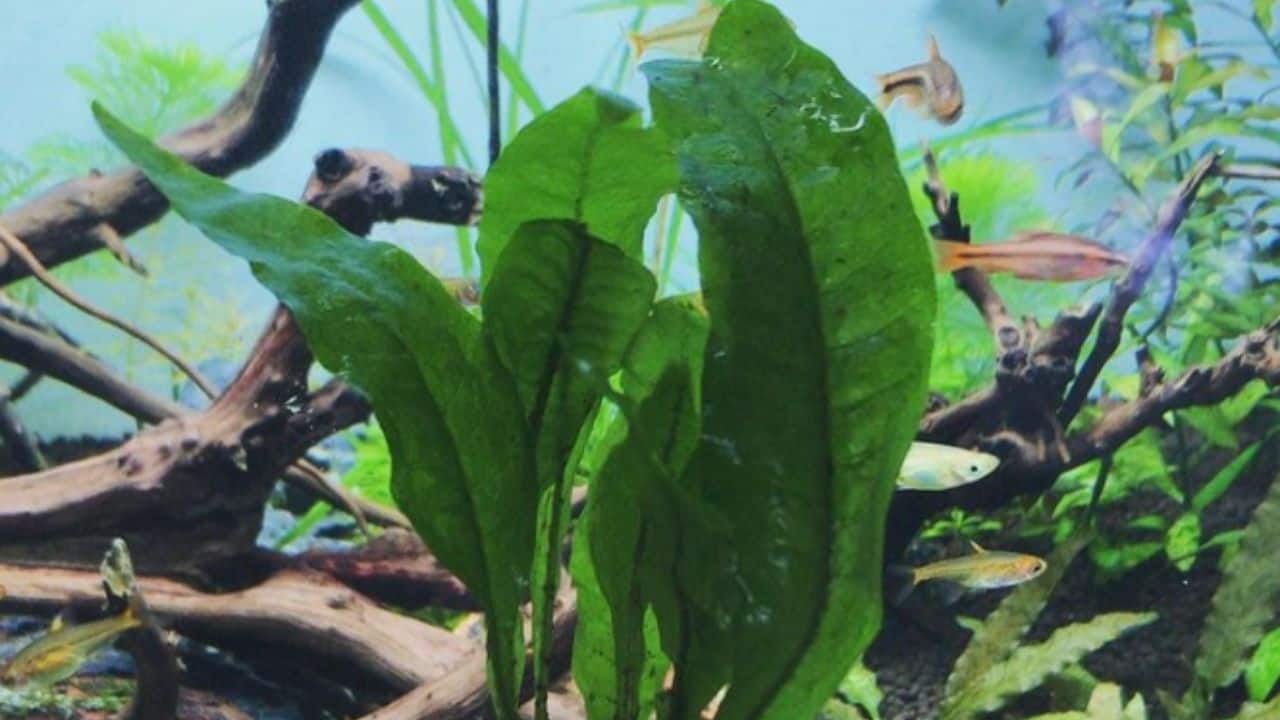
Photo Credit: @the_fishgeek on Instagram!
Java Fern got its name from Java, Indonesia, and is an easy-to-care-for plant.
Java Fern features a lot of varieties such as:
- Window
- Trident
- Narrow-leaf
- Pointed leaves
The most popular Java Fern has pointed leaves that are long and contain ridged veins. Its roots and leaves sprout from a thinking stem.
Thus, you should not plant the rhizome into the soil. Instead, you can keep the plant in between two rocks or pieces of wood.
Its binomial nomenclature and basic plant care include:
- Scientific name: Leptochilus pteropus
- Common names: Java Fern
- Family: Polypodiaceae
- Temperature: 70-75 degrees Fahrenheit (21-23 degrees Celsius)
- Fertilizer: Needs moderate amount of fertilizer but prefers liquid fertilizers
- Soil: no specific soil requirement as the roots do not need to be planted into the soil
- Lighting: Moderate to low lighting
- Humidity: Extremely high to underwater
- Growth rate: Low to moderate
- Placement: Should be placed in the middle of the back of the tank
10. Dwarf Sagittaria
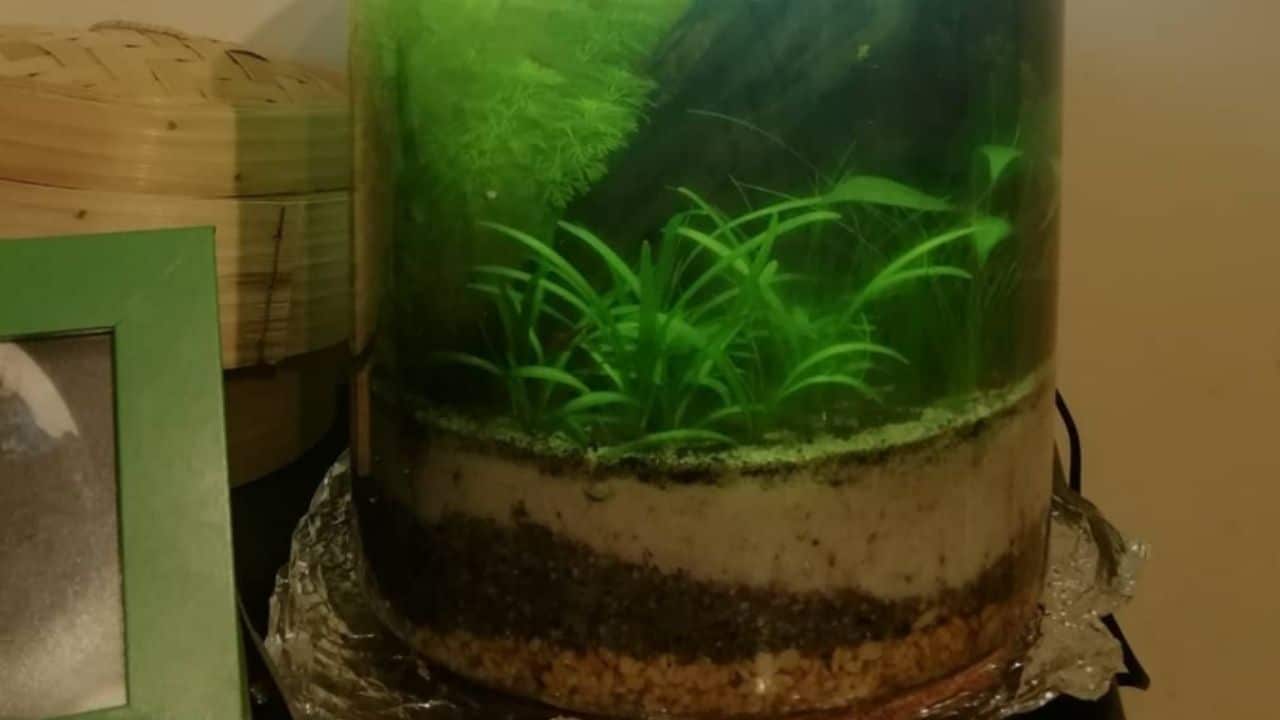
Photo Credit: @delerio88 on Instagram!
Dwarf Sagittaria looks like the miniature version of Vallisneria. It’s a grass-like, hardy plant that thrives easily and can live long.
Its binomial nomenclature and basic plant care include:
- Scientific name: Dwarf Sagittaria
- Common names: Dwarf Sagittaria
- Family: Alismataceae
- Temperature: 64-79 degrees Fahrenheit (17-26 degrees Celsius)
- Fertilizer: Needs to be fertilized often (once a week)
- Soil: needs nutrient-rich soil that contains high amounts of iron
- Lighting: Low light
- Growth rate: fast
- Placement: Foreground or mid-ground
Dwarf Sagittaria is quite a unique plant as the lighting plays a huge role in how much the plant grows.
Its lighting requirements are unique because even though it can grow in brightness, the species thrives under low lighting.
11. Rotala Indica
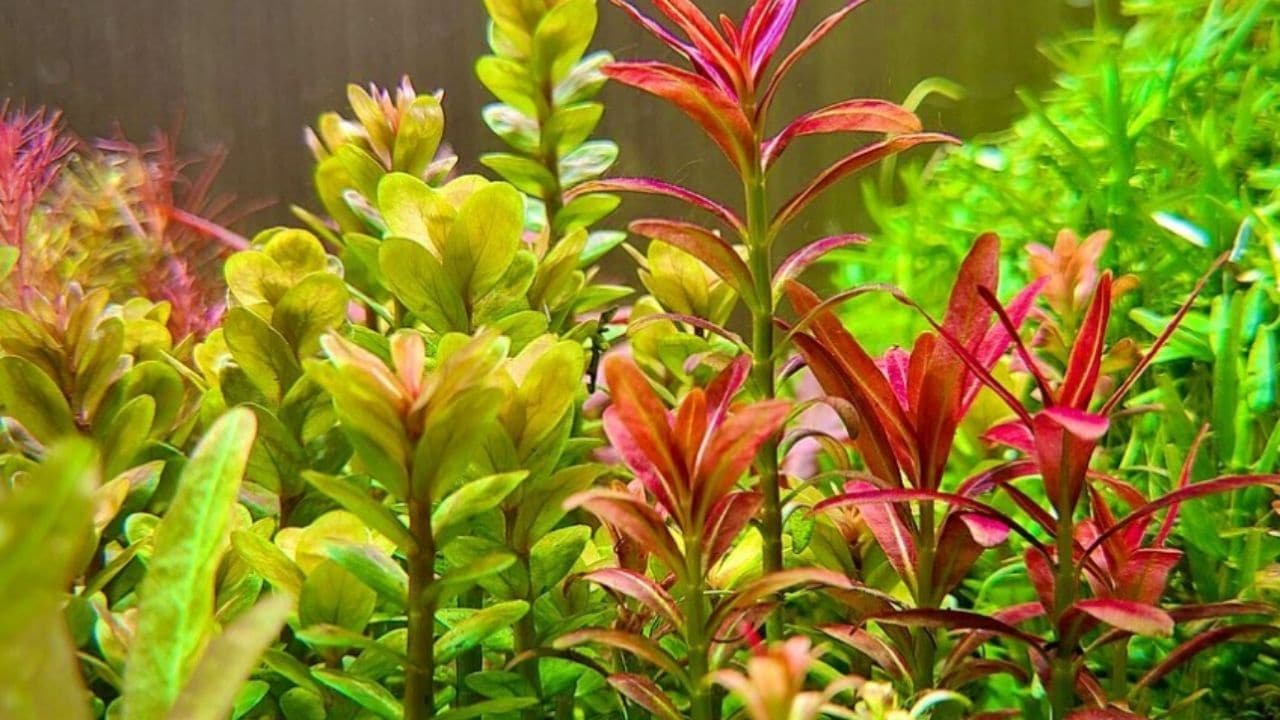
Photo Credit: @duke_aquarium on Instagram!
Rotala Indica is a unique plant that is known for its special decorative aesthetic look and distinct shape. These stems and leaves grow upwards, and the plant creates oxygen pearls to help oxygenate your tank.
Its binomial nomenclature and basic plant care include:
- Scientific name: Rotala Indica
- Common names: Indian Toothcup
- Family: Lythraceae
- Temperature: 62 and 82-degrees Fahrenheit (17-28 degrees Celsius)
- Fertilizer: Needs to be fertilized once or twice a month
- Soil: needs nutrient-rich soil
- pH levels: 6.0 to 7.5
- Water hardness: 3 to 8 KH
- Lighting: grows under various lighting conditions
- Growth rate: Grows fast when exposed to high lighting conditions
- Placement: can be kept anywhere in the tank
Rotala Indica does not just provide an aesthetic look but also helps improve the conditions of your water within the aquarium by:
- Absorbing carbon dioxide to release oxygen.
- Getting rid of the contaminants
- Enriching the water environment
12. Cabomba
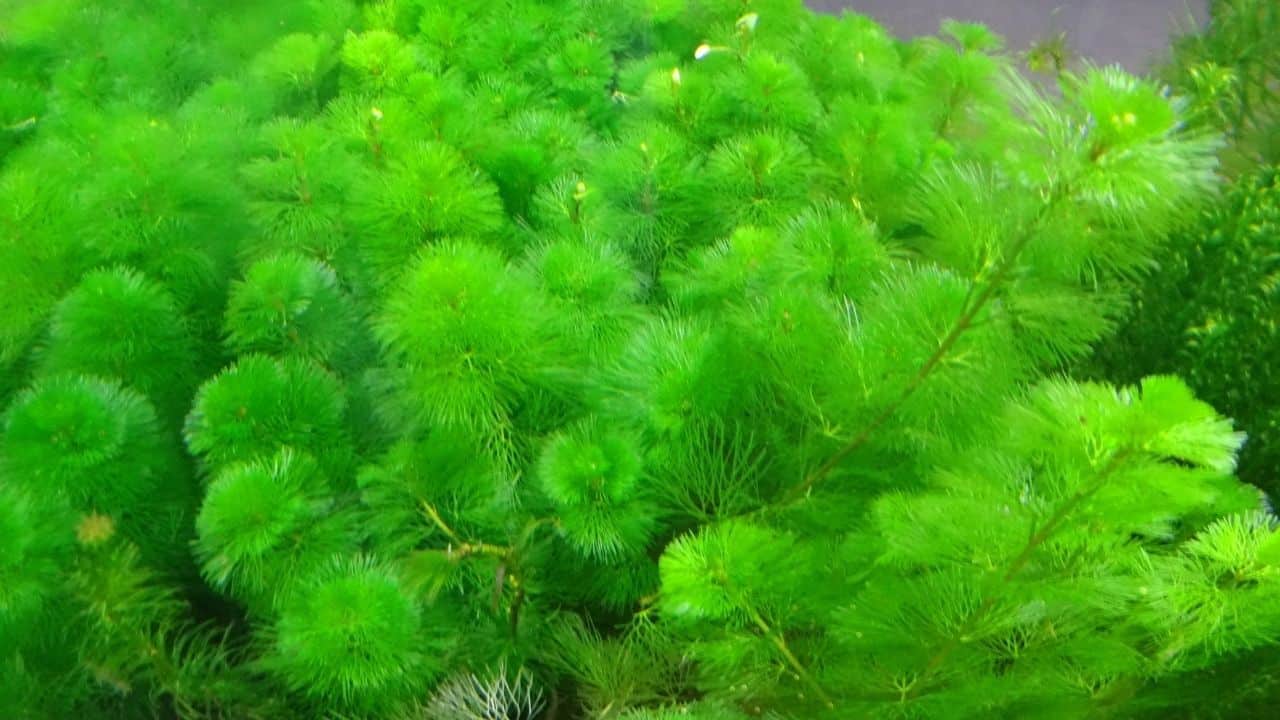
Cabomba is a stunning stem plant that is known for its fluffy appearance and adjustability to cold-water aquariums. It’s not incredibly easy to grow, but lighting is the main focus for its care.
Its binomial nomenclature and basic plant care include:
- Scientific name: Cabomba
- Common names: Carolina fanwort and Carolina water shield
- Family: Cabombaceae
- Temperature: 72-82 degrees Fahrenheit (22 to 27 degrees Fahrenheit)
- Fertilizer: needs to be fertilized often. Root tabs work best
- Soil: No specific soil requirement
- Lighting: Moderate to high lighting
- Growth rate: Rapid growth rate
- Placement: Background of the tanks
This plant can be left free-floating, but it looks better in the background within an aquascape.
Cabomba can be found in many different varieties, such as:
- Green (most common variety of Cabomba in the market.)
- Red
- Purple
13. Ludwigia Repens
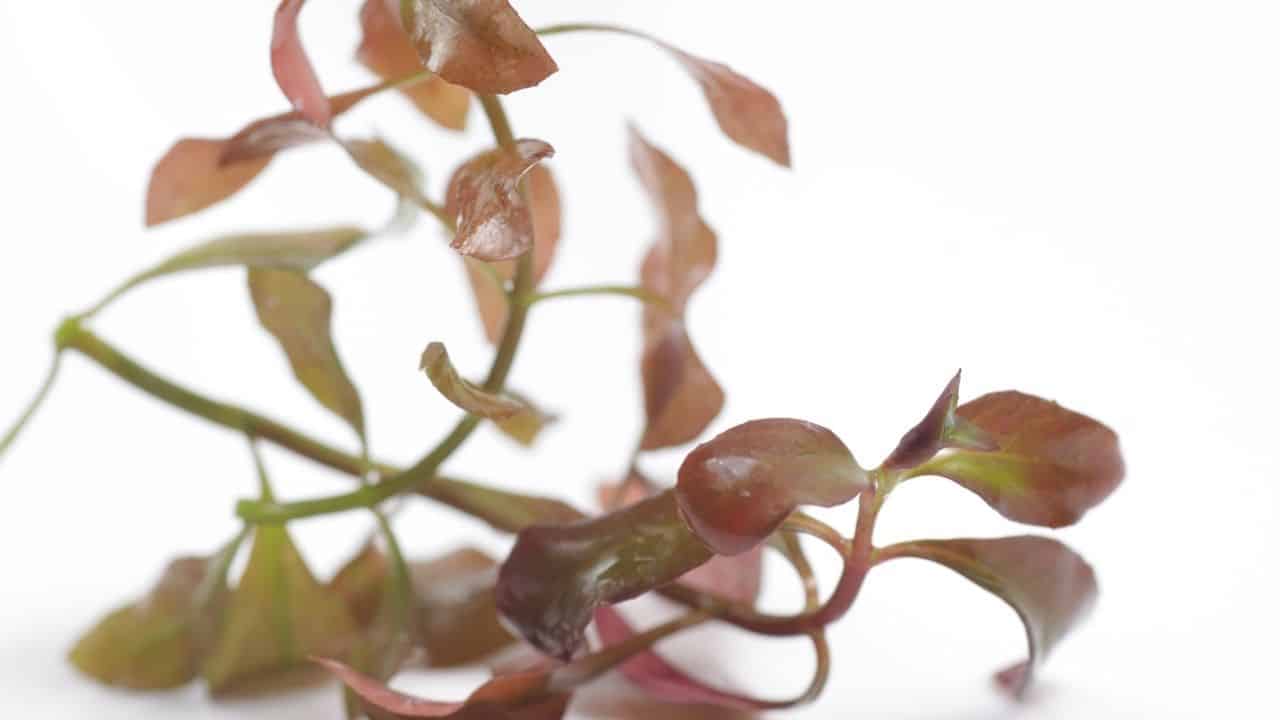
Ludwigia Repens is similar to Rotala Rotundifolia. It thrives when kept under proper lighting and turns into a lovely red color when the right amount of lighting is provided.
Its binomial nomenclature and basic plant care include:
- Scientific name: Ludwigia Repens
- Common names: Creeping Primrose-Willow
- Family: Onagraceae
- Temperature: 75–79 degrees Fahrenheit (23 to 26 degrees Celsius)
- Fertilizer: It doesn’t require lots of fertilizer
- Soil: There are no specific soil requirements
- Lighting: mediums to high lighting
- Growth rate: Depends on the surrounding.
- Placement: mid-ground or background of aquariums
14. Crinum Calamistratum
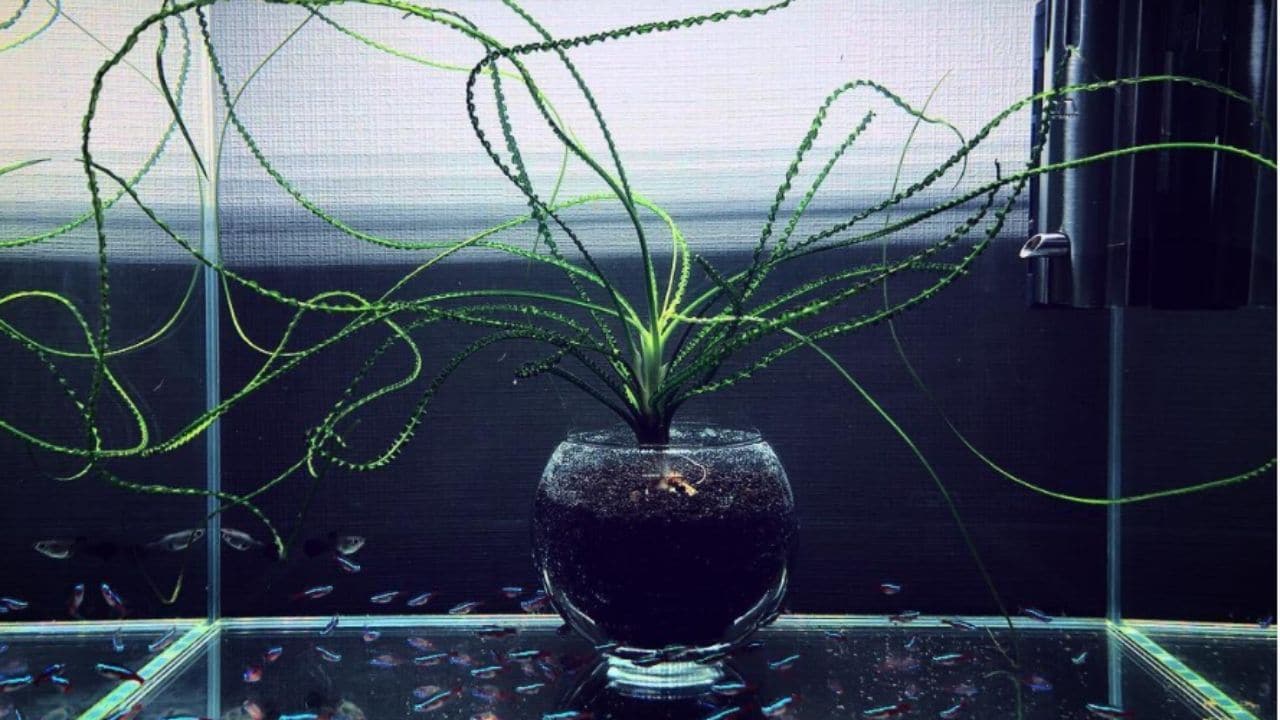
Photo Credit: @570_4 on Instagram!
Crinum Calamistratum is a unique plant perfect for anyone looking for very tall aquarium plants. This plant is bulbous and contains narrow crinkled leaves.
The unique look makes it very eye-catching. Its binomial nomenclature and basic plant care include:
- Scientific name: Crinum Calamistratum
- Common names: African Onion Plant
- Family: Amaryllidaceae
- Temperature: 68 to 82.4 degrees Fahrenheit (20 to 28 degrees Celsius)
- pH: 6.0 – 8.0
- Fertilizer: does not require extra fertilizer
- Soil: no specific soil requirements
- Lighting: medium to high
- Growth rate: slow
- Placement: midsections or the back of the tank
Crinum Calamistratum can grow well if even carbon dioxide injections are provided.
As long as you leave the plant alone and do not disturb it too much, you do not need to worry about its growth.
Conclusion
Everyone wants to make sure their tank is filled with beautiful aquarium plants that make them look like a whole other world.
It is always better to start with beginner-friendly plants as you can successfully set up your aquarium.
Bushy plants are the best choice for aquariums because they liven up the place without much effort and you can see the place thrive before you get expertise.
If you do not see healthy growth in the first few weeks, do not get discouraged, as these things take time. With patience, you will have a lush and thriving aquarium in no time.

